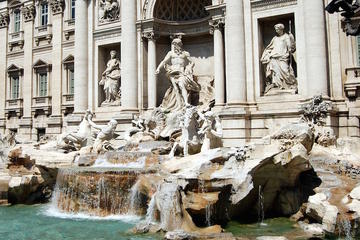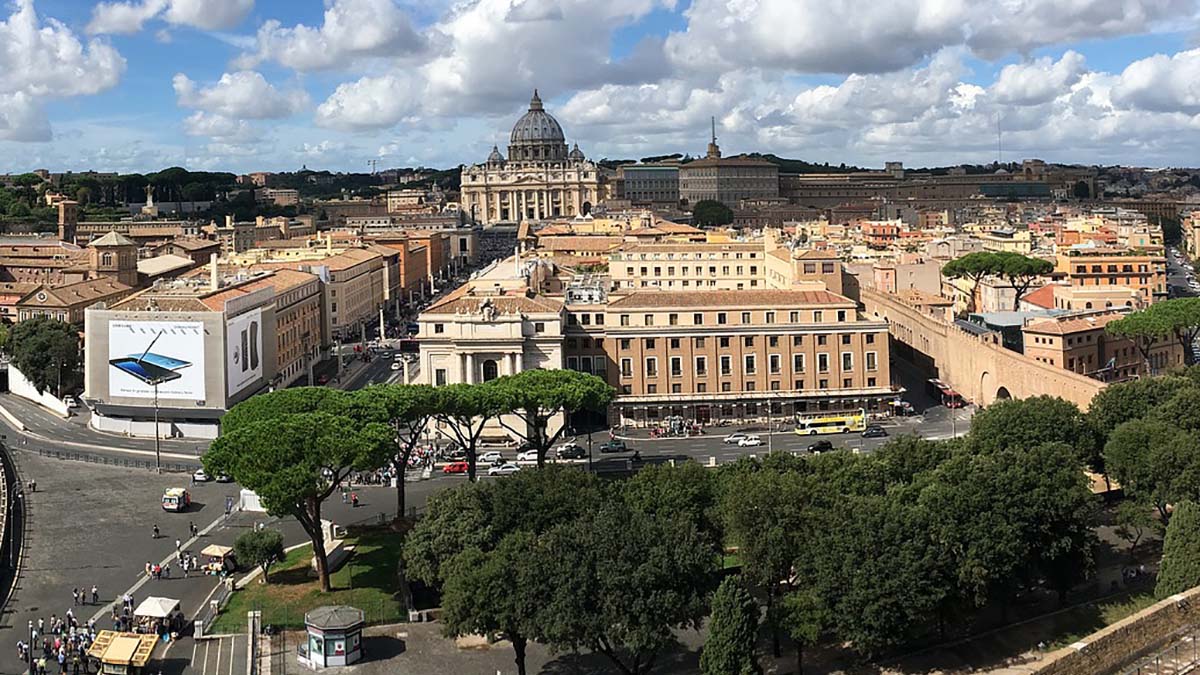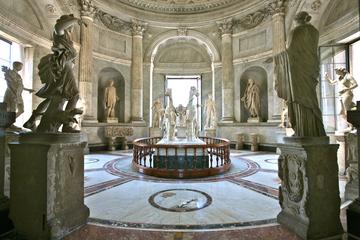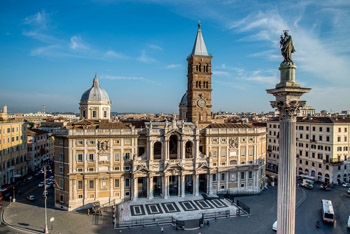
The Gathering Point
by Ron Ellege
What do dancing young people, senior sojourners, and Pope Francis have in common? The Basilica of Santa Maria Maggiore in Rome, Italy.
Viewing its Activity
When in Rome, our go to hotel is the Mecenata Palace which is a worthy refuge of elegance, located atop Esquiline Hill. The hotel is directly across the street from the Basilica, and our requested room provides an unobstructed view of the church.
 Over the years we have watched groups gather at twilight for the beginning of their pub crawls. Dividing into teams, they guzzle through drinking games in the piazza while preparing for their evening of revelry. We have observed crowds gather for marches, tours, protests and rallies. From blurry eyed, early morning senior groups touring the Basilica, to high-spirited youth groups assembling to sing and dance in the square, this church is a well celebrated gathering point.
Over the years we have watched groups gather at twilight for the beginning of their pub crawls. Dividing into teams, they guzzle through drinking games in the piazza while preparing for their evening of revelry. We have observed crowds gather for marches, tours, protests and rallies. From blurry eyed, early morning senior groups touring the Basilica, to high-spirited youth groups assembling to sing and dance in the square, this church is a well celebrated gathering point.
On June 4, 2015, Pope Francis visited Santa Maria Maggiore to celebrate the annual Solemnity of Corpus Christy. The hotel provides an excellent vantage point for this festival held each year on the Basilica steps. My article and pictures of this assembly can be viewed at, “Pope Francis visits Santa Maria Maggiore.”
Importance and Prestige of this Basilica
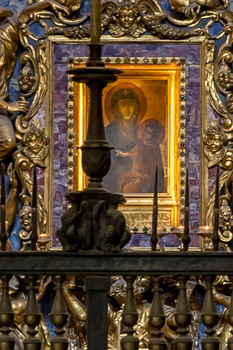 There are over 25 churches in Rome dedicated to Mary, Santa Maria Maggiore is the largest of these Marian churches. This Major Papal Basilica is prominent in the tradition and adulation of the Catholic community worldwide. Many travel blogs rate Santa Maria as one of the ten most beautiful churches in Europe. Walks of Italy tour Major Basilicas of Rome, includes it as one of “the three most important churches in Rome.” Frommer’s rates it #3 in its article; “The Best Churches.” If you are a cathedral buff, Italy is not complete until you have experienced this great lady.
There are over 25 churches in Rome dedicated to Mary, Santa Maria Maggiore is the largest of these Marian churches. This Major Papal Basilica is prominent in the tradition and adulation of the Catholic community worldwide. Many travel blogs rate Santa Maria as one of the ten most beautiful churches in Europe. Walks of Italy tour Major Basilicas of Rome, includes it as one of “the three most important churches in Rome.” Frommer’s rates it #3 in its article; “The Best Churches.” If you are a cathedral buff, Italy is not complete until you have experienced this great lady.
Located on Esquiline Hill, one of the ancient “Seven Hills of Rome,” the present Basilica dates back to the fifth century AD. It was constructed between 432 and 440 to celebrate the major output of the 431 Council of Ephesus. In Catholic tradition, the Basilica is an attestation of the importance of the Virgin Mary as the Mother of God.
This Basilica is Rome’s only remaining example of early Christian architecture whose core structure remains as it was 1600 years ago. Step in the door and wonder surrounds you, grand and modest – simple yet extravagant, art which captures the eye is witnessed in every direction. The mosaics found in Santa Maria Maggiore are among the oldest representations of the Virgin Mary in Christian Antiquity. Revelations of human thought, presented through combinations of differing styles of mosaic expression.
The Nave and Triumphal Arch
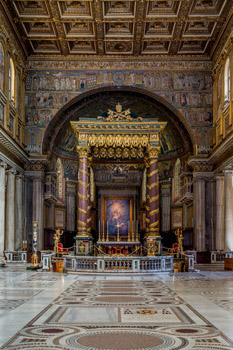 The golden mosaics adorning the triumphal arch date from the 5th century and depict scenes from the early life of Christ and the Virgin Mary. On the left at the top is a panel depicting Christ’s enthronement with a group of angels as his court. Below this is the Epiphany or Adoration of the Magi. The young Christ is seated on a throne with Mary on his right, they are attended by angels.
The golden mosaics adorning the triumphal arch date from the 5th century and depict scenes from the early life of Christ and the Virgin Mary. On the left at the top is a panel depicting Christ’s enthronement with a group of angels as his court. Below this is the Epiphany or Adoration of the Magi. The young Christ is seated on a throne with Mary on his right, they are attended by angels.
Panels on the Right side of the triumphal arch include the Presentation in the Temple; the Flight into Egypt; Herod visited by the Magi; the city of Bethlehem. The top center panel displays a circle containing the apocalyptic throne of Christ with the Book of the Seven Seals, flanked by St. Peter and St. Paul.
The Apse
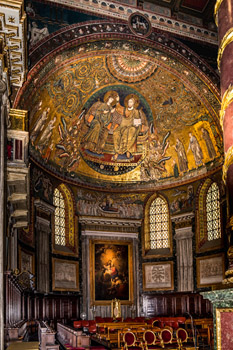 Italian painter and mosaic maker Jacopo Torriti is credited with the adornment of the apse, he crafted it in 1295. The magnificent central work shows the Coronation of the Virgin in which Jesus and Mary are seated on a throne with Jesus placing a jeweled crown on Mary’s head. The sun and moon are under their feet accompanied by a choir of adoring angels. Standing to their left are St. Peter, St. Paul, St. Francis of Assisi and Pope Nicholas IV. Standing on the right is St. John the Baptist, St. John the Evangelist, St. Anthony and Cardinal Colonna. The apse of Santa Maria Maggiore is the most important surviving example of Roman mosaic art from the late middle ages. Descend below the high altar and you enter the burial place of Saint Jerome, this 4th-century saint translated the Bible into the Latin language (the Vulgate). Upstairs, located in the Borghese Chapel, is “Salus Populi Romani,” believed to be the oldest Marian image in Rome. However, on display in this vault is arguably the most important artifact of the Basilica, The Reliquary of the Holy Crib. This crystal shrine, designed by Giuseppe Valadier, is said to contain wood from the Holy Crib of the nativity of Jesus Christ.
Italian painter and mosaic maker Jacopo Torriti is credited with the adornment of the apse, he crafted it in 1295. The magnificent central work shows the Coronation of the Virgin in which Jesus and Mary are seated on a throne with Jesus placing a jeweled crown on Mary’s head. The sun and moon are under their feet accompanied by a choir of adoring angels. Standing to their left are St. Peter, St. Paul, St. Francis of Assisi and Pope Nicholas IV. Standing on the right is St. John the Baptist, St. John the Evangelist, St. Anthony and Cardinal Colonna. The apse of Santa Maria Maggiore is the most important surviving example of Roman mosaic art from the late middle ages. Descend below the high altar and you enter the burial place of Saint Jerome, this 4th-century saint translated the Bible into the Latin language (the Vulgate). Upstairs, located in the Borghese Chapel, is “Salus Populi Romani,” believed to be the oldest Marian image in Rome. However, on display in this vault is arguably the most important artifact of the Basilica, The Reliquary of the Holy Crib. This crystal shrine, designed by Giuseppe Valadier, is said to contain wood from the Holy Crib of the nativity of Jesus Christ.
The Legend of the Snowfall
 Legend has it that an aristocrat named Giovanni, and his barren wife were without child. Seeking divine intervention they committed to build a church to the Virgin Mary. She appeared to them in a dream on the night of August 4, 352 A.D. and told them that a miracle would show them the location on which they were to build the church. That night, Pope Liberius was troubled by the same dream. On the following morning, he travelled to Esquiline Hill and found it miraculously covered in snow. Liberius then traced an outline for the location of the planned church. Although many feel this legend has little basis in fact, to this day the church on Esquiline Hill is often referred to as Our Lady of the Snow.
Legend has it that an aristocrat named Giovanni, and his barren wife were without child. Seeking divine intervention they committed to build a church to the Virgin Mary. She appeared to them in a dream on the night of August 4, 352 A.D. and told them that a miracle would show them the location on which they were to build the church. That night, Pope Liberius was troubled by the same dream. On the following morning, he travelled to Esquiline Hill and found it miraculously covered in snow. Liberius then traced an outline for the location of the planned church. Although many feel this legend has little basis in fact, to this day the church on Esquiline Hill is often referred to as Our Lady of the Snow.
 5 Reasons to visit Santa Maria Maggiore
5 Reasons to visit Santa Maria Maggiore
1. The opulence of its décor.
♦ This gem will keep your camera snapping and your eyes twinkling from the grandeur of its marble floors, tapestries, mosaics, statues, tombs and relics.
♦ Its spectacular ceiling is said to be decorated with gold which Columbus transported from the new world.
2. The freedom to move about with little crowding
♦ Check the schedule for special occasions and visit any other time.
♦ Only on rare occasions is this venue crowded.
3. Proximity and ease of access
♦ A four block walk from the main train station and Termini Underground.
♦ The city bus stop is on the corner of the piazza
♦ A scheduled stop for all Hop On Hop Off tours
♦ Only a ten minute walk from the Colosseum.
4. It’s FREE! There is no cost of admission
♦ Stay as long as you want, return as often as you please.
5. Its prominence and status among Rome’s churches
♦ Santa Maria Maggiore is one of the Seven Pilgrim Churches of Rome
♦ It stands among the four patriarchal basilicas
Maria Maggiore is listed as a “Top 10 Attraction” and “Must See Venue” in most major guide books, including Rick Steves’.


If You Go:
Expect to spend several hours in this grand Basilica and by all means, bring a camera. Guided tours can be arranged through many of the local or world-wide guide services such as Frommer’s or Walks of Italy. Self-guided tours, complete with audio guides are available in the vestibule. For information visit their official website.
Hours of Operation: The Santa Maria Maggiore Basilica is open Monday through Saturday from 7:00 to 19:00 (in winter until 18:00), on Sundays and holidays from 9:30 to 12:00. Free admission.
How to get there: get off at the stop termini of the underground; take via Cavour southwest 4 blocks, the Basilica is on your left. The Basilica is located on the square with the same name – Piazza di Santa Maria Maggiore also referred to as Piazza dell’Esquilino.
Address: Piazza di S. Maria Maggiore, 42, 00100 Roma RM, Italy
Phone: +39 06 6988 6800
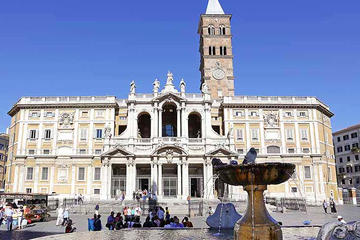
Churches of Rome Small-Group Tour: Maria Maggiore, Santa Pudenziana, and Basilica di Santa Prassede
About the author:
Ron Elledge is a Freelance Writer/Photographer. You can see some of his work at these sites:
www.writtenfyi.com (blog)
www.ronelledgeexposed.com (photography)
ron@writtenfyi.com (email)
All photos are by Ron Elledge.

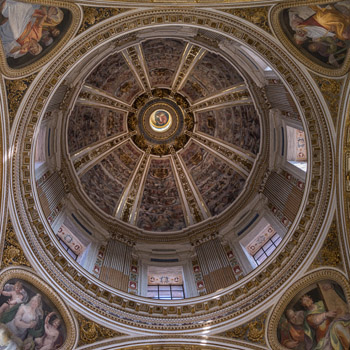 5 Reasons to visit Santa Maria Maggiore
5 Reasons to visit Santa Maria Maggiore
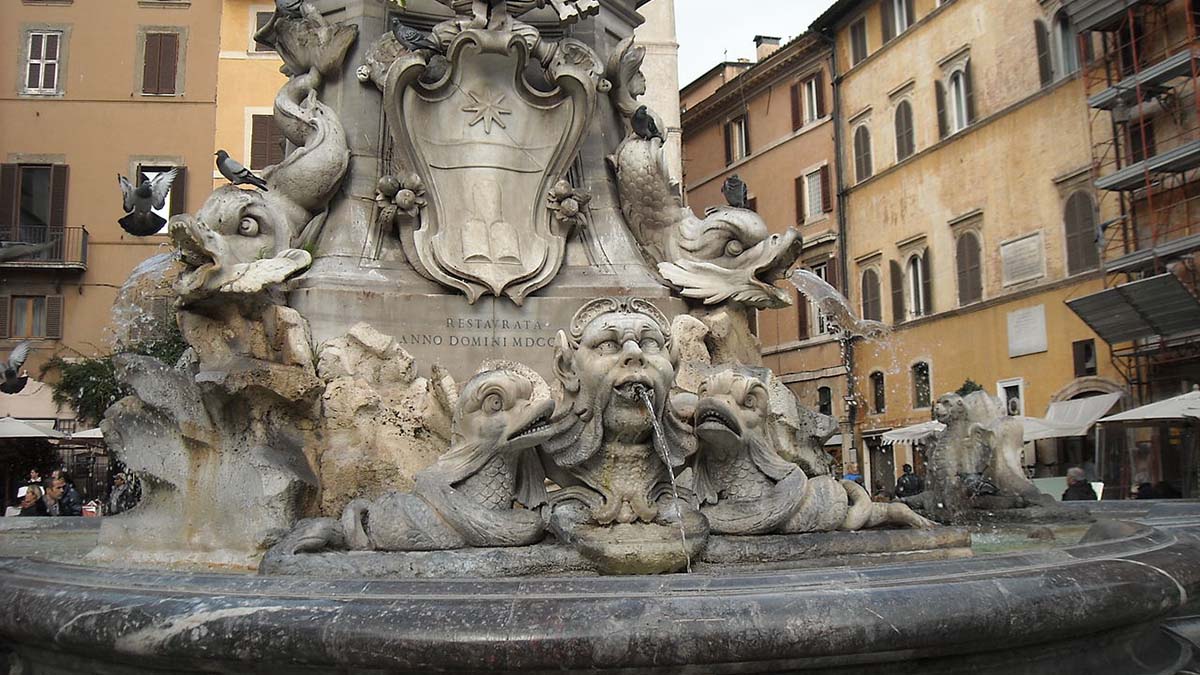
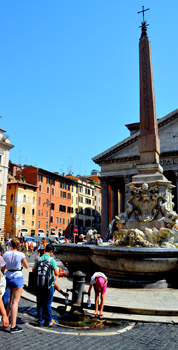 My husband and I arrived in Rome during the heat wave that broke records all across Europe in the summer of 2015. After a week of sweltering in temperatures up to 36.7 (99.68 F) in London and 39.7 C (103 F) in Paris, we were resigned to buying bottled water at every possible opportunity. We were about to learn that Rome is actually better prepared to handle thirsty tourists than most major cities, and that it has been for centuries.
My husband and I arrived in Rome during the heat wave that broke records all across Europe in the summer of 2015. After a week of sweltering in temperatures up to 36.7 (99.68 F) in London and 39.7 C (103 F) in Paris, we were resigned to buying bottled water at every possible opportunity. We were about to learn that Rome is actually better prepared to handle thirsty tourists than most major cities, and that it has been for centuries.
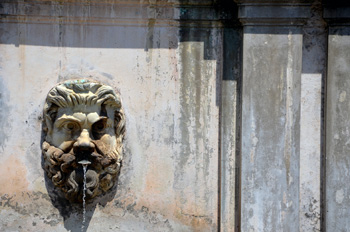 The apparent wastefulness of all that water flowing 24/7 isn’t lost on the city. During the 1980s the city added taps to the fountains, requiring that thirsty Romans operate a nob or button in order to drink. The results were far from satisfying. On hot days, water standing in the pipes heated up, making it less than appealing. Vandals broke the new taps, freeing the flow of the water, and officials gave up on the project. The water doesn’t go entirely to waste. It’s recycled to grow gardens, flush sewers and in industrial cleaning.
The apparent wastefulness of all that water flowing 24/7 isn’t lost on the city. During the 1980s the city added taps to the fountains, requiring that thirsty Romans operate a nob or button in order to drink. The results were far from satisfying. On hot days, water standing in the pipes heated up, making it less than appealing. Vandals broke the new taps, freeing the flow of the water, and officials gave up on the project. The water doesn’t go entirely to waste. It’s recycled to grow gardens, flush sewers and in industrial cleaning.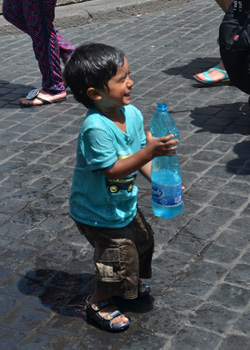 I found one that wasn’t in use on a side street as my husband and I walked back to our hotel from Trevi Fountain on a very hot afternoon. I wondered for a second if it was functional, but as I stepped around it I found a stream of fresh cool water splashing into a grate at my feet. I splashed my face and filled my bottle. By the time I was done, a couple of people had queued up behind me. I felt as much like a native as a brief visitor can feel.
I found one that wasn’t in use on a side street as my husband and I walked back to our hotel from Trevi Fountain on a very hot afternoon. I wondered for a second if it was functional, but as I stepped around it I found a stream of fresh cool water splashing into a grate at my feet. I splashed my face and filled my bottle. By the time I was done, a couple of people had queued up behind me. I felt as much like a native as a brief visitor can feel.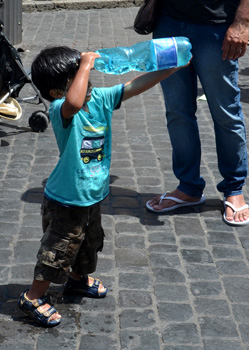 Do give the nasoni of Rome a try while you’re there. Your first time may feel a bit daunting, but once you try it, I’ll bet you’re sold on this delicious free resource.
Do give the nasoni of Rome a try while you’re there. Your first time may feel a bit daunting, but once you try it, I’ll bet you’re sold on this delicious free resource.

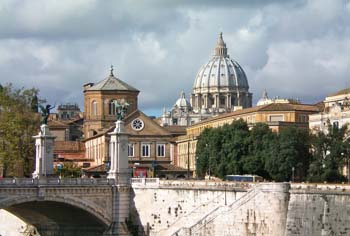
 In 293 BC, Rome suffered from one of the many pestilences which proved the tribulation of the Ancient world. Seeking divine aid, a delegation of high priests and doctors made a pilgrimage to Aesculapius’ temple at Epidaurus. In response to their prayers and offerings, one of the temple’s sacred The success of the quest was thus assured. Upon the ship’s return to Rome, the snake slithered into the Tiber and crossed to the reed-covered island, which lay opposite the city’s port. This was so obvious a sign Aesculapius desired a temple here, not only was one built but the island itself hewn to resemble a ship. Large structures of white travertine were built at either end to augment the resemblance to prow and stern, complete with a bust of Aesculapius and his caduceus. In the centre of the island an obelisk was raised to suggest the main mast of a Roman galley. Thus dedicated to the powerful god of healing, the Isola Tiberina has been associated with the care of the sick ever since.
In 293 BC, Rome suffered from one of the many pestilences which proved the tribulation of the Ancient world. Seeking divine aid, a delegation of high priests and doctors made a pilgrimage to Aesculapius’ temple at Epidaurus. In response to their prayers and offerings, one of the temple’s sacred The success of the quest was thus assured. Upon the ship’s return to Rome, the snake slithered into the Tiber and crossed to the reed-covered island, which lay opposite the city’s port. This was so obvious a sign Aesculapius desired a temple here, not only was one built but the island itself hewn to resemble a ship. Large structures of white travertine were built at either end to augment the resemblance to prow and stern, complete with a bust of Aesculapius and his caduceus. In the centre of the island an obelisk was raised to suggest the main mast of a Roman galley. Thus dedicated to the powerful god of healing, the Isola Tiberina has been associated with the care of the sick ever since. With the growth of Rome, the reputation of the Isola Tiberina’s temple and its doctors grew such that the sick ventured here from all over the Empire to seek healing. Like its namesake at Epidaurus, the temple became famous for the drinking of its miraculous waters, and for dream cures. Most probably opium (or a similar opiate) was used to produce a drugged state filled with dreams, hallucinations, and a susceptibility to suggestion. Hypnosis was a key factor; priests appeared in the dim, smoky light dressed as Aesculapius, and sacred snakes and dogs flickered their tongues over ailing body parts. The fame of these cures was to outlast both the Roman and Greek Empires.
With the growth of Rome, the reputation of the Isola Tiberina’s temple and its doctors grew such that the sick ventured here from all over the Empire to seek healing. Like its namesake at Epidaurus, the temple became famous for the drinking of its miraculous waters, and for dream cures. Most probably opium (or a similar opiate) was used to produce a drugged state filled with dreams, hallucinations, and a susceptibility to suggestion. Hypnosis was a key factor; priests appeared in the dim, smoky light dressed as Aesculapius, and sacred snakes and dogs flickered their tongues over ailing body parts. The fame of these cures was to outlast both the Roman and Greek Empires.
 The hospital can be reached from the Left Bank via the Ponte Fabricio, which links the Old Ghetto to the island. At the junction of the two join stands the Pierloni-Caetani Tower. Built by the Pierloni family before 1000 AD at one of the most strategic approaches along the Tiber to Medieval Rome, it was used first by the Pierlonis and then the Caetanis for control of the river. Jewish in origin, the Caetani family was to produce a pope, Anacletus II. The Adjacent Pierloni-Caetani Castle, which fronts onto the Piazza San Bartolomeo, served as a fortress for several fugitive popes in the Middle Ages. It became a Franciscan monastery in the 17th century, and is now the Tiber Island History museum.
The hospital can be reached from the Left Bank via the Ponte Fabricio, which links the Old Ghetto to the island. At the junction of the two join stands the Pierloni-Caetani Tower. Built by the Pierloni family before 1000 AD at one of the most strategic approaches along the Tiber to Medieval Rome, it was used first by the Pierlonis and then the Caetanis for control of the river. Jewish in origin, the Caetani family was to produce a pope, Anacletus II. The Adjacent Pierloni-Caetani Castle, which fronts onto the Piazza San Bartolomeo, served as a fortress for several fugitive popes in the Middle Ages. It became a Franciscan monastery in the 17th century, and is now the Tiber Island History museum.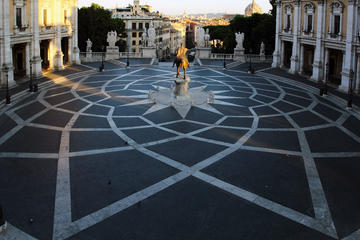

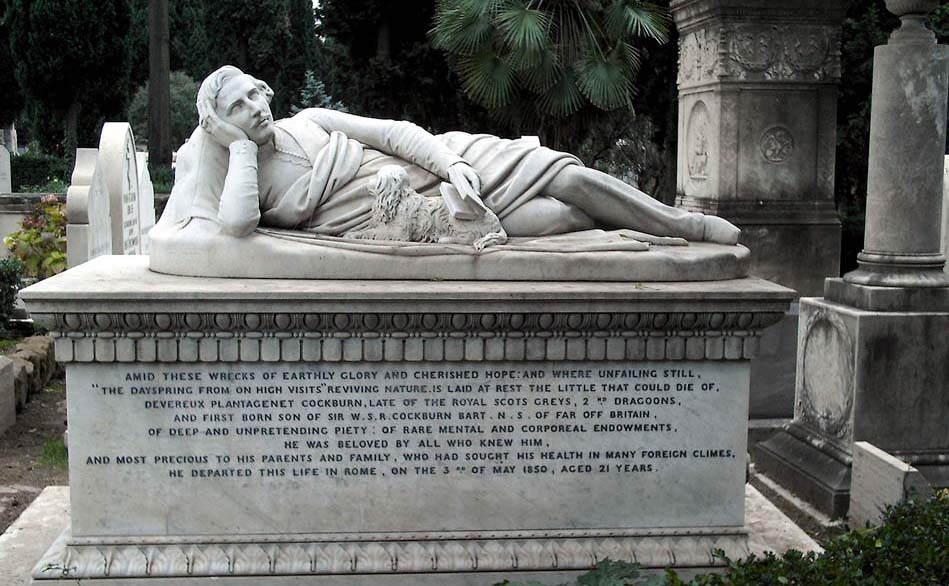
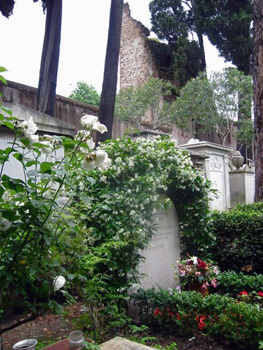 Perhaps Italians might disagree with me when I use this term, since this, the Cimitero Acattolico, is the last resting place for those who could not, or would not be buried in the traditional Catholic cemeteries here in the heart of Roman Catholicism. But hallowed it is, nonetheless, since this patch of land, overgrown with weeds and flowers, contains the remains of the some of the most important figures of the last few centuries: local dissidents and those from other lands, ex-pats, writers, revolutionaries, atheists and Jews who, famous or not, all came to rest together here in this painfully beautiful monument to non-conformity. Antonio Gramsci, Gregory Corso, and a cat named Romeo are some among this motley crew, though none of them hold higher places in the echelons of artistic memory than the two greats of English Romanticism buried here: John Keats and Percy Bysshe Shelley. How could it not be raining, then? It was as if the luminous Roman sky had been replaced for a moment by a melancholy English one, pausing to weep a bit for two lost sons, entombed amidst the ruins, far far away.
Perhaps Italians might disagree with me when I use this term, since this, the Cimitero Acattolico, is the last resting place for those who could not, or would not be buried in the traditional Catholic cemeteries here in the heart of Roman Catholicism. But hallowed it is, nonetheless, since this patch of land, overgrown with weeds and flowers, contains the remains of the some of the most important figures of the last few centuries: local dissidents and those from other lands, ex-pats, writers, revolutionaries, atheists and Jews who, famous or not, all came to rest together here in this painfully beautiful monument to non-conformity. Antonio Gramsci, Gregory Corso, and a cat named Romeo are some among this motley crew, though none of them hold higher places in the echelons of artistic memory than the two greats of English Romanticism buried here: John Keats and Percy Bysshe Shelley. How could it not be raining, then? It was as if the luminous Roman sky had been replaced for a moment by a melancholy English one, pausing to weep a bit for two lost sons, entombed amidst the ruins, far far away.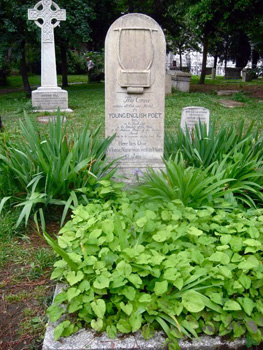 Though their names are often intertwined, John Keats and Percy Shelley came to Italy for very different reasons. Shelley, the rebellious Etonian from an Aristocratic family, was leading a wild life, one easier experienced abroad. He was best friends with Lord Byron and romantically entangled with Mary Wollstonecraft Godwin (turned Shelley), the author of Frankenstein. His lifestyle, radical views, and writing had brought him not only fame, but also infamy. Like many writers and artists of his day, he was attracted to the warmth of the European south, to its classical pagan origins, and to that fact that he could live freely there, away from the scandals that plagued him in England. Keats, on the other hand, came to Italy to die.
Though their names are often intertwined, John Keats and Percy Shelley came to Italy for very different reasons. Shelley, the rebellious Etonian from an Aristocratic family, was leading a wild life, one easier experienced abroad. He was best friends with Lord Byron and romantically entangled with Mary Wollstonecraft Godwin (turned Shelley), the author of Frankenstein. His lifestyle, radical views, and writing had brought him not only fame, but also infamy. Like many writers and artists of his day, he was attracted to the warmth of the European south, to its classical pagan origins, and to that fact that he could live freely there, away from the scandals that plagued him in England. Keats, on the other hand, came to Italy to die.
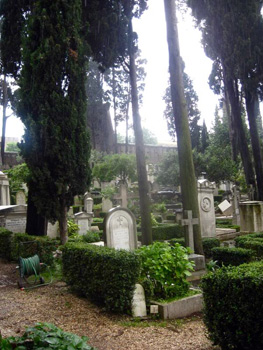 Besides the cruelty inherent in this statement, the irony was palpable too. Keats’ medical training, no matter how practical it may have been, could do nothing to stop what was then an almost incurable disease, tuberculosis. Not long after his brother died, it became clear that John Keats had contracted the illness too. Knowing that he would not survive the English winter, his friends gathered whatever money they could in order to send him to a gentler climate, a last ditch attempt to save his life.
Besides the cruelty inherent in this statement, the irony was palpable too. Keats’ medical training, no matter how practical it may have been, could do nothing to stop what was then an almost incurable disease, tuberculosis. Not long after his brother died, it became clear that John Keats had contracted the illness too. Knowing that he would not survive the English winter, his friends gathered whatever money they could in order to send him to a gentler climate, a last ditch attempt to save his life.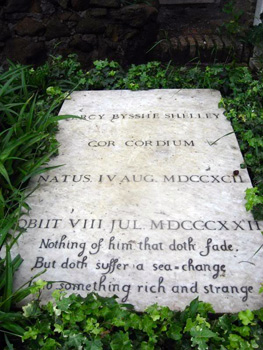 Shelley was buried in the same cemetery a mere year later, the victim of a violent Mediterranean storm that drowned him while sailing off the coast of northern Italy. A book of John Keats’ poetry was found in his pocket. Shelley’s cremated remains (all but his heart, which was kept by Mary Shelley and eventually buried in England) can be found under a small flat tombstone a short walk from Keats’, bearing the Latin “Cor Cordium” (heart of hearts), and a quote from Shakespeare’s The Tempest: “Nothing of him that doth fade, But doth suffer a sea-change is to something rich and strange.”
Shelley was buried in the same cemetery a mere year later, the victim of a violent Mediterranean storm that drowned him while sailing off the coast of northern Italy. A book of John Keats’ poetry was found in his pocket. Shelley’s cremated remains (all but his heart, which was kept by Mary Shelley and eventually buried in England) can be found under a small flat tombstone a short walk from Keats’, bearing the Latin “Cor Cordium” (heart of hearts), and a quote from Shakespeare’s The Tempest: “Nothing of him that doth fade, But doth suffer a sea-change is to something rich and strange.”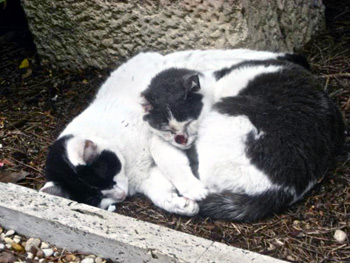 On my own visit, while I sat there overcome with tears, I heard a rustling from the wall above me. From out of one of the vines came a black and white cat, who jumped down onto the bench, and then snuggled up onto my lap. Through my own teary-eyed haze and quixotic imagination, it was easy to believe that in that moment I was being visited by the spirit of the poet himself. Of course, as I got up to walk to Shelley’s grave, straight ahead and to the right, I realised that the cat was just one among many strays who live in the cemetery, and to whose livelihood you can also donate money. However, the impression stayed with me, there on that wet rainy day, as I wandered alone through the grounds of the Cimitero Acattolico. And I emphasize the word “alone”, because visitors here are many fewer than in other famous cemeteries such as Père Lachaise or in Roman tourist spots like Saint Peter’s. When Oscar Wilde visited in 1877, he called it “the holiest place in Rome”. There, breaking bread with the dead, it’s not hard to see why.
On my own visit, while I sat there overcome with tears, I heard a rustling from the wall above me. From out of one of the vines came a black and white cat, who jumped down onto the bench, and then snuggled up onto my lap. Through my own teary-eyed haze and quixotic imagination, it was easy to believe that in that moment I was being visited by the spirit of the poet himself. Of course, as I got up to walk to Shelley’s grave, straight ahead and to the right, I realised that the cat was just one among many strays who live in the cemetery, and to whose livelihood you can also donate money. However, the impression stayed with me, there on that wet rainy day, as I wandered alone through the grounds of the Cimitero Acattolico. And I emphasize the word “alone”, because visitors here are many fewer than in other famous cemeteries such as Père Lachaise or in Roman tourist spots like Saint Peter’s. When Oscar Wilde visited in 1877, he called it “the holiest place in Rome”. There, breaking bread with the dead, it’s not hard to see why.